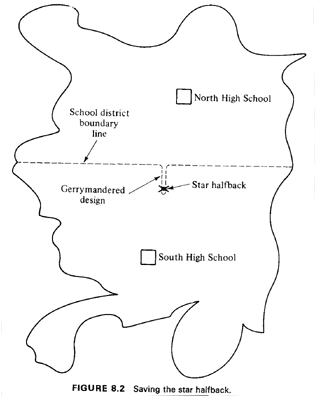


8.1.4 Busing to BuildThe causes for success or failure in implementing a study are often complicated, requiring months, perhaps years, to discover. Probably the most successful of the student projects in the MIT graduate course related to this book involved the redeployment of public school buses in a suburb of Boston. (This project occurred before the recent court-ordered busing of schoolchildren in Boston to achieve racial balance.) Each year this municipality put a contract out for bid to bus-leasing companies to provide the community's school busing services during the coming year. The cost of the contract turned out to be almost directly proportional to the number of buses required, which as specified by the municipality in accordance with the bus routes and schedules annually developed by the Department of Schools. Over the years is community had grown considerably, with new housing occupying once undeveloped land. As a result, the number of schools and school-bus routes ad increased greatly. School-bus routes had been added on top of existing routes, with often two (and in one case three) buses stopping at the same stop at different times in the morning to transport children to the same school! For their project, a group of three of our students worked with members of the School Committee to redraw school bus routes and reschedule their arrival and departure times (the same bus would make several trips in the morning, as elementary, junior high, and high schools each had different starting times). By employing a good deal of common sense and a number of neuristic routing techniques from network analysis, the students prepared a commended redeployment of buses for one of the junior high schools. After giving a class presentation, which was attended by the Superintendent of Schools of that suburb, they were invited to present their results formally the entire School Committee. Almost immediately after their formal presentation, they were hired by the School Committee to work through the summer on implementing a new us routing and scheduling system in September for the entire school system This they did, but not without some problems. For instance, the newly derived bus routes suggested changing slightly the areas served by the "north" and "south" high schools. This shift caused the star football halfback for one of the schools to be reassigned to the other, the two being arch Thanksgiving Day rivals. Such a redesign was deemed politically unacceptable and resulted in gerrymandering that maintained the halfback's school allegiance Figure 8.2). Other factors were also considered, such as safe locations for -turns of buses and safe walkways for students, requiring extensive driving throughout the town to discover its idiosyncracies. Finally, after certain data collection problems had been resolved in August, the plan was implemented on schedule in September. A telephone complaint service was set up to respond to calls from parents. This resulted in some further modifications of he bus deployment plan until the final plan for the year was arrived at approximately 2 weeks after the start of school. The cost to the town for the students' summer professional services was
10,000. The savings in school-bus costs to the town for the first year
alone ere about $130,000, amounting to about 26 percent of its annual
$500,000 ill for the school-bus services.

Virtually no one in a decision-making position objected to this study, and most supported it vigorously-an occurrence that is almost unparalleled in the authors' experiences. Within the following year, we discovered some of the hidden ingredients. First, the school superintendent was new at the job, having been hired the preceding spring; he did not have to bear the legacy for past inefficiencies. In addition, the person whose duty it had been to design school bus routes had retired at approximately the time the new superintendent took office. Thus, there was no one around to defend old policies. Most important, however, the school superintendent had a "hidden agenda": he was trying to put before the electorate a $12,000,000 schoolconstruction bond issue, and the documented savings for school busing of $130,000 per year (and a 13: 1 benefit cost ratio during that first year alone) demonstrated that he was "frugal," and, by implication, that the bond issue must be necessary. |


